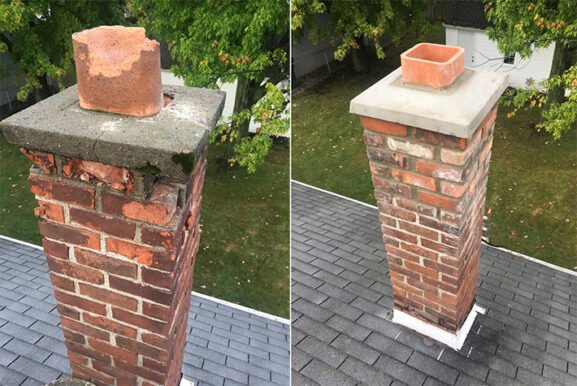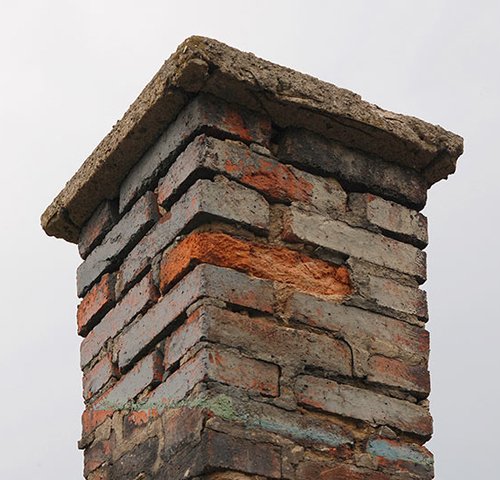Why Addressing a Leaning Chimney Now Can Prevent Bigger Structural Problems
Key Takeaways
- A leaning chimney is often a sign of deep structural issues that can compromise your home’s safety
- Ignoring the problem can lead to water damage, masonry deterioration, and even roof damage
- Professional inspection is essential to determine the root cause and best repair approach
- Early intervention can help reduce repair costs and preserve the chimney’s structural integrity
What Causes a Chimney to Lean
A leaning chimney doesn’t happen overnight. It’s usually the result of underlying structural problems that build up over time. One common cause is foundation settling. If the soil under your chimney shifts or erodes, the structure may begin to tilt gradually. This is particularly common in older homes where the chimney has no deep footing or has been exposed to fluctuating moisture levels in the soil.
Another factor is water infiltration. When water seeps into mortar joints and bricks, it weakens them over time. Freezing and thawing cycles can worsen this damage, pushing bricks apart and creating instability. A damaged or missing chimney cap or flashing can speed up this process.
Trees growing too close to the home can also affect chimney alignment. Their roots may alter the soil or physically press against the foundation.
Signs Your Chimney Is Leaning and Needs Immediate Attention
It’s not always easy to spot a leaning chimney until the issue becomes severe. However, there are warning signs to look out for:
- Visible gaps between the chimney and the house wall
- Cracked or crumbling bricks and mortar joints
- Water stains inside your attic near the chimney
- Misaligned chimney crown or flue
- Uneven fireplace floors or shifting inside the firebox
If any of these signs are present, a certified chimney specialist should be called in for a thorough inspection. A delay could lead to additional structural damage or even a chimney collapse.
The Dangers of Ignoring a Leaning Chimney
It might be tempting to write off a slight tilt as just an age-related imperfection. But the consequences can be serious. A leaning chimney can compromise the roofline, pull away from your home’s exterior, and allow water to seep in through the gaps. Over time, this creates rot, mold, and decay within nearby wooden structures.
More alarmingly, if the chimney leans too far, it can collapse. This risk increases if your region experiences high winds or seismic activity. Falling masonry is not just a structural hazard; it poses safety risks to anyone nearby.
Also, since chimneys are connected to fireplaces and heating systems, any shift can affect ventilation. This increases the risk of carbon monoxide exposure or backdrafting.
How Professionals Diagnose the Problem
A qualified chimney repair expert will start by assessing the tilt visually and using specialized tools to measure angles and shifts. From there, they may inspect the foundation, check the brickwork for signs of moisture infiltration, and look at how well the chimney integrates with the rest of the home.
Sometimes, a leaning chimney is due to a faulty footing that never extended below the frost line. Other times, it’s the result of gradual mortar decay. Professionals can also use video scanning to inspect interior flue liners and determine if cracks or misalignment are affecting chimney function.
Depending on findings, the next step might involve soil testing, especially if ground shifting is suspected.
Repair Options Based on Severity
The right repair method depends on how severe the lean is and what’s causing it. In cases where the chimney is structurally sound but the footing has shifted, underpinning might be the solution. This involves stabilizing the foundation with piers or concrete supports to realign the chimney.
If the masonry is failing due to water damage or freeze-thaw cycles, partial or full chimney rebuilding may be needed. This allows for the installation of a proper footing and the use of modern, water-resistant materials.
For chimneys with minor lean but damaged flashing or crown, targeted repairs can prevent further damage. Replacing the flashing, repairing mortar joints (tuckpointing), and sealing bricks can halt the progression of the tilt.
In every case, the work should be completed by a professional with experience in structural masonry and chimney systems. You can refer to standards set by organizations like the Chimney Safety Institute of America (CSIA) for best practices.
Cost Considerations You Should Know
Leaning chimney repair costs vary widely. A simple tuckpointing job might cost a few hundred dollars, while full structural realignment or reconstruction can run into the thousands. On average, expect to pay between $1,000 and $5,000 depending on the scope of the issue.
Other factors that influence cost include chimney height, location, materials needed, and whether interior fireplace components also require adjustment. Waiting to fix a leaning chimney can make things worse — and more expensive.
Insurance coverage can sometimes apply, especially if the damage is linked to a specific incident like a storm or earthquake. It’s a good idea to consult both your chimney contractor and your insurer early in the process.
Why Timely Repair Preserves Your Home’s Longevity
Acting quickly on a leaning chimney isn’t just about fixing something that looks off — it’s about protecting the long-term structure of your home. Chimneys are integral to your roof, your foundation, and your heating system. Letting the issue linger can affect everything from your home’s insulation to its resale value.
Moisture that enters through cracks can weaken other building materials. A leaning structure can damage roofing, soffits, and gutters. By resolving the problem early, you ensure a safer, more energy-efficient home that holds its value.
Timely repairs also mean you avoid having to replace the entire chimney, which is one of the more expensive fixes in home maintenance.
Final Thoughts on Long-Term Prevention and Maintenance
Once a leaning chimney is repaired, preventative care becomes your best defense. Schedule annual chimney inspections, especially after winter seasons. Keep an eye on water drainage near your home to prevent soil erosion. Install or replace chimney caps and make sure flashing is in good shape.
These simple steps can extend the life of your chimney and protect your home from future damage. Investing a little time each year can save you from major structural headaches down the road.

